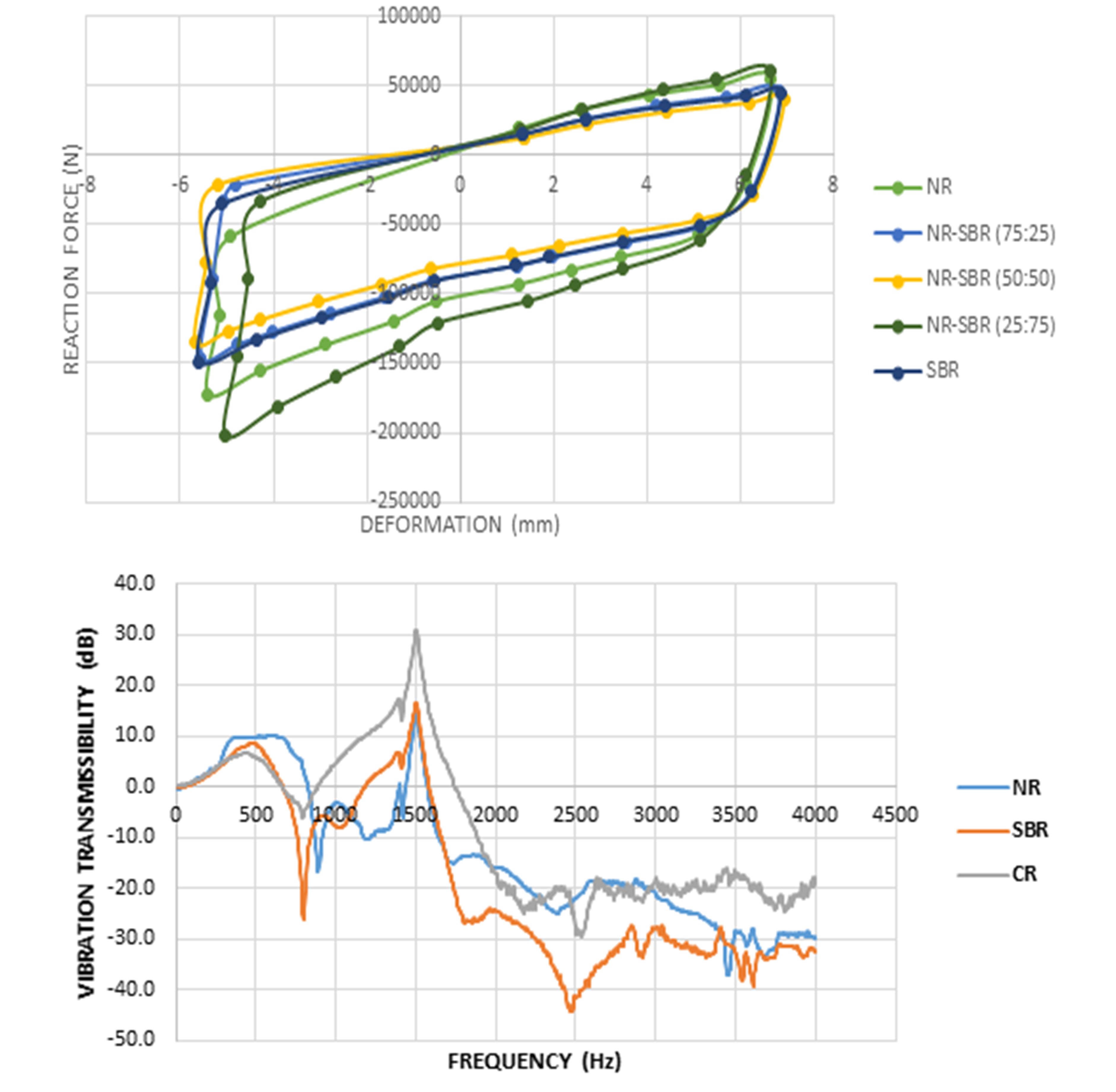Experimental and Numerical Analysis of the Performance of Various Damper Materials
DOI:
https://doi.org/10.48048/tis.2023.5038Keywords:
Damping material, Hysteresis, Elastomers, Loss factor, VibrationAbstract
The vibration in ships causes structural fatigue, damage to electrical and mechanical devices, excessive level of noise and discomfort to the passengers and crews. Sometimes the increase in ship vibration leads to unsafe operating conditions and thereby discarding it. Thus, the research on vibration reduction is essential in the maritime field and this paper deals with the reduction of vibrations in marine machinery using elastomeric bearings. The numerical analysis of the performance of passive vibration isolators with different damping materials was conducted using ANSYS and the results are validated experimentally. With the help of a vibration exciter, vibration transmissibility at different frequencies is plotted and the hysteresis curve was generated numerically by applying a cyclic load to the bearing. Then, the best damping material was deducted by comparing the calculated loss factor of different elastomeric materials such as natural rubber, styrene-butadiene rubber and polybutadiene Rubber (PBR) and their combinations. The natural rubber blended with styrene-butadiene rubber (SBR) and polybutadiene rubber (PBR) shows an increase in the damping property of the elastomer and can be used for high-frequency damping applications.
HIGHLIGHTS
- Study of damping property of various elastomers. Experimental as well as numerical analysis were done to find the loss factor of elastomers
- The transmissibility curve of the elastomers was plotted at different frequencies ranging from 10 - 4000 Hz using a vibration exciter and the loss factor was calculated using half power band width method
- Hysteresis curve of elastomers were generated numerically using ANSYS software and the loss factor of the elastomers was calculated theoretically
GRAPHICAL ABSTRACT
Downloads
Metrics
References
S Krishnamoorthi, S Nagendharan and RS Praveen. Investigation of vibration behavior of fluorocarbon mounts. Int. Res. Eng. Tech. 2018; 5, 3051-4.
H Wan, Y Li and L Zheng. Vibration and damping analysis of a multilayered composite plate with a viscoelastic mid layer. Shock Vib. 2016; 2016, 6354915.
RA Ibrahim. Recent advances in nonlinear passive vibration isolators. J. Sound Vib. 2008; 314, 371-452.
VS Chavan, R Askhedkar and SB Sanap. Analysis of anti-vibration mounts for vibration isolation in diesel engine generator set. Int. J. Eng. Res. Appl. 2013; 3, 1423-8.
A Valeev, A Zotov and S Kharisov. Designing of compact low frequency vibration isolator with quasi-zero-stiffness. J. Low Freq. Noise Vib. Active Contr. 2015; 34, 459-73.
PS Bharat, BB Shivprakash, GT Sandeep and M Samata. Design and analysis of antivibration mount for G+3 elevator. Int. J. Curr. Eng. Tech. 2014; 7, 103-8.
SS Devi, M Niveshim, R Subesh and M Rohan. Experimental behaviour of elastomeric bearing on bridge structures. Int. J. Recent Tech. Eng. 2019; 8, 7856-9.
M Ahmadipour and MS Alam. Sensitivity analysis on mechanical characteristics of lead-core steel-reinforced elastomeric bearings under cyclic loading. Eng. Struct. 2017; 140, 39-50.
A Mathai and MS Manasa. Performance of lead rubber bearing as a base isolator. Int. J. Sci. Tech. Eng. 2017; 3, 33-6.
A Das, A Dutta and SK Deb. Modelling of fibre-reinforced elastomeric base isolators. In: Proceedings of the 15th World Conference on Earthquake Engineering, Lisbon, Portugal. 2012.
BY Moon, GJ Kang, BS Kang and DS Cho. Design of elastomeric bearing system and analysis of its mechanical properties. J. Mech. Sci. Tech. 2004; 18, 20-9.
A Krishnamoorthy and M Jayavel. Design and analysis of vibration isolation pad of a heavy load machine and to perform the progressive rate frequency analysis. ARPN J. Eng. Appl. Sci. 2017; 12, 4709-16.
SP Barale and SS Gawade. Internal combustion engine vibrations and vibration isolation. Int. J. Sci. Eng. Res. 2017; 8, 243-7.
AR Lavhande and SB Tuljapure. Comparison of transmissibility of non-metallic materials for vibration isolation. IOSR J. Mech. Civ. Eng. 2013; 4, 57-61.
VG Geethamma, R Asaletha, N Kalarikkal and S Thomas. Vibration and sound damping in polymers. Resonance 2014; 19, 821-33.
JH Lee, KJ Lee, HG Park and JH Kim. Possibility of air filled rubber membrane for reducing hull exciting pressure induced by propeller cavitation. Ocean Eng. 2015; 103, 160-70.
M Moshrefi-Torbati, JA Forrester, AI Forrester, AJ Keane, MJ Brennan and SJ Elliott. Novel active and passive anti-vibration mountings. J. Sound Vib. 2012; 331, 1532-41.
X Zhao, J Yang, D Zhao, Y Lu, W Wang, L Zhang and T Nishi. Natural rubber/nitrile butadiene rubber/hindered phenol composites with high-damping properties. Int. J. Smart Nano Mater. 2015; 6, 239-50.
S Emad and TN Hamid. Finite element modelling of horizontal load displacement hysteresis loops in unbonded elastomeric isolators. Structures 2021; 34, 2987-95.
KN Kalfas, AM Stergios and K Katakalos. Numerical study on the response of steel-laminated elastomeric bearings subjected to variable axial loads and development of local tensile stresses. Eng. Struct. 2017; 134, 346-57.
W Wei, P Tan, Y Yuan and H Zhu. Experimental and analytical investigation of the influence of compressive load on rate-dependent high-damping rubber bearings. Constr. Build. Mater. 2019; 200, 26-35.

Downloads
Published
How to Cite
Issue
Section
License
Copyright (c) 2022 Walailak University

This work is licensed under a Creative Commons Attribution-NonCommercial-NoDerivatives 4.0 International License.






